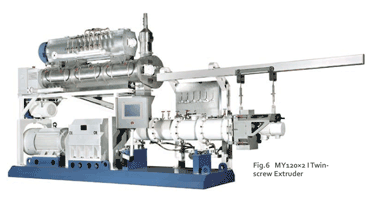Energy efficiency improving & pellet uniformity control in the extrusion of aquafeed
To substantially improve extruder performance in aquafeed production, in recent years Muyang Group made research efforts in five aspects and gained some achievements : to increase energy efficiency of extruder, to enhance pellet uniformity, to lengthen service life of wear parts, to increase production rate of sinking aquafeed as well as that of micro-aquafeed, among which, the energy efficiency improving technology and its application as well as the development on pellet uniformity control will be introduced in the present article.
1. How did Muyang increase energy efficiency of the extruder system
With the development of extrusion technology, one of the development trends in aquafeed milling is that extruder is taking the place of pellet mill and becomes the most popular and most efficient milling machine because of its flexible production adaptability, high product quality and high sanitation assurance. However, the obstacle impeding extruder popularization is energy input, which must be decreased.
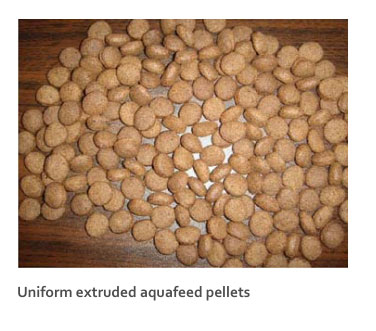
As we all know, sufficient energy is required to put into the extrusion system to sustain the whole extrusion process, from material conditioning to kneading, shearing, cooking, extruding, forming and finally obtaining qualified aquafeed. Essentially, the input energy is normally defined into two forms: the specific mechanical energy (SME) and the specific thermal energy (STE).
Analyzing from the energy inputs that required for cooking the raw recipe components, there are three possible ways to improve energy efficiency of an extrusion system, i.e. to increase production capacity while decrease the power consumption:
(1) Improve the utilization efficiency of SME;
(2) Improve the utilization efficiency of STE;
(3) Try to input and utilize most STE from the
relatively cheaper source -- steam to substitute some SME input.
1.1 Method to maximize SME utilization
First of all, the approach was studied to match the SEM input with that required for material ripening. If lower than that required, the input SME could not ripen the material sufficiently even though it would result in higher production capacity, vice versa. Therefore, only proper SME input can guarantee high quality extruded aquafeed while maximizing production capacity.
By quantifying the abilities of each screw segment (including conveying, shearing and mixing abilities) and testing the effects of different screw combinations, Muyang extruder research team found out the optimal screw configuration that can achieve proper SEM input for a given auquafeed production task.
Based on above mentioned studies and a perceptual as well as rational knowledge of extrusion technology, Muyang extrusion team worked out a new concept — “stabilized shearing”.
Usually, the whole extrusion process that material undergoes, from being fed into the extruding chamber up to being extruded out of the die plate, is a “hasty shearing” process accompanied by high pressure, high power consumption and high wearing of working parts, and also unconstant discharge of extrudates.
The stabilized shearing technology brought by Muyang Group can largely stabilize the shearing efficiency in the whole extrusion process (see Fig.1). The optimal screw configuration can not only impart extrusion process proper SME inputs but also ensure the product gelatinization not less than that of the “hasty shearing technology”. It has been proven that, when producing aquafeed with the stabilized shearing technology, an extruder can increase the capacity by 15% with an energy savage of 12% per ton of feed.
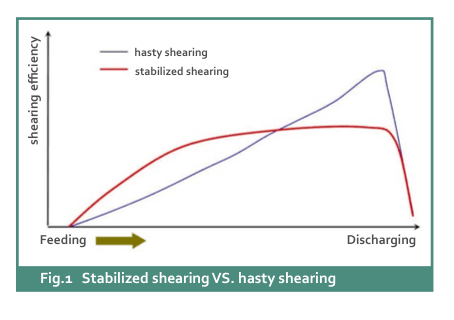
1.2 Method to maximize STE utilization
Aquafeed mash needs to be pre-cooked in the conditioner by hot steam before entering into the extruder chamber for extrusion. How to maximize the utilization of thermal energy from a given amount of steam to improve the gelatinization of aquafeed mash in the conditioner has been the focus of Muyang’s research efforts for years.
The moisture and heat of steam is hard to penetrate into the core of feed mash particles and “cook” them just by the simple physical mixing function of a conventional conditioner, especially for the oil-rich aquafeed mash. That means more steam and longer conditioning time has to be given in order to achieve high mash gelatinization.
Targeting the goal of improving steam utilization and enhancing feed gelatinization, Muyang has invented the “reinforced conditioning technology”, which can improve the mass and heat transfer efficiency and uniformity of steam effectively. In addition, Muyang has innovated the SPTZ series Complex Conditioner by combining the reinforced conditioning technology with a Muyang SCTZ DDC Conditioner, which achieves excellent conditioning performance. See Table 1 and Fig.2.
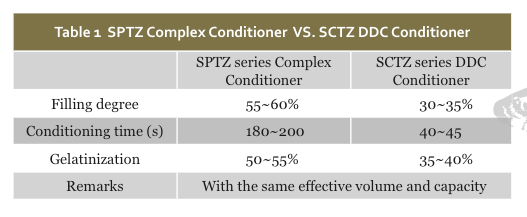
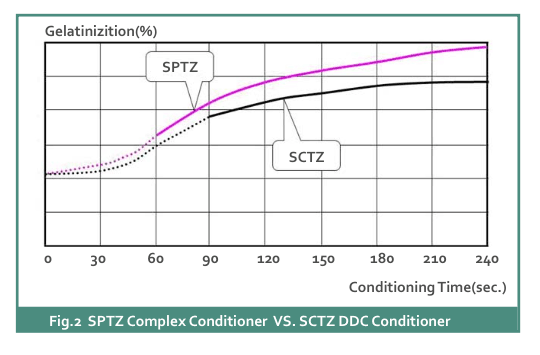
Besides, the production capacity of an extrusion system equipped with a SPTZ Complex Conditioner is able to increase by 10-15% compared to that with a common DDC conditioner, because of the thorough pre-cooking function in the conditioning process. Furthermore, the enhanced pre-cooking could bring in more stable running of the machine and less wear of the working parts such as the segmented screws and extruding chamber liner, which alternatively is saving maintenance cost.
1.3 Substitute SME with steam thermal energy
As we all know, the same energy in steam thermal form is far cheaper than that in electric power form. And the SME input to a running extruder always comes from electric power supply. What if some part of the required electric power is substituted with steam thermal energy, the production cost of aquafeed will be decreased significantly.
During cooking, the amount of steam thermal energy utilized by feed mash is determined by conditioner pressure. For instance, conditioned by saturated steam, the highest conditioning temperature that feed mash can achieve is 100oC under 0.1MPa while can reach 164.19oC under 0.6MPa. Therefore, on one hand to make full use of steam thermal energy under ambient condition, on the other hand to optimize the conditioning pressure and maximize the steam energy utilization.
The more the steam energy being utilized by feed mash, the less the SME required for extrusion.
The “substituting SME with steam thermal energy” technology is widely used in the Muyang extruders and has been proven to be an effective and economic way.
2. How did Muyang control pellet uniformity in aquafeed extrusion
Good pellet uniformity and pleasing appearance are the important and attractive characters for high quality aquafeed. However, the relationship between good pellet uniformity and high production capacity is hard to balance, just like you can’t have your cake and eat it too, especially for the single-screw extruder. As the production capacity increases, the pellet uniformity declines. Usually, good pellet uniformity can be gained when the extruder is running at 70~80% of its rated load.
Essentially, the nonuniform extruded pellets are generated by materials lacking homogeneity in the whole feed milling process. From grinding to mixing, conditioning, extruding and forming, material’s lack of proper homogeneity in any of these processes will finally cause nonuniform extruded pellets. Fortunately, material homogeneity in the grinding, mixing and conditioning processes is easy to be controlled with available techniques. The most challenge is to control feed mash homogeneity during extruding.
What are the causes of nonuniform feed mash during extruding? See Fig.3

(1) Nonuniform shearing force. The more difference of shearing force brought by extruding screw stressing on feed mash, the more nonuniform gelatinization and the more nonuniform pellet finally achieved.
(2) Different flow rate. Flow rate of feed mash during extruding could be different in two zones: the screw zone and the non-screw zone (between the end of screw and the die plate). The different flow rate of feed mash in the extruder will cause different ripening time, and different gelatinization as well as different pellets quality accordingly.
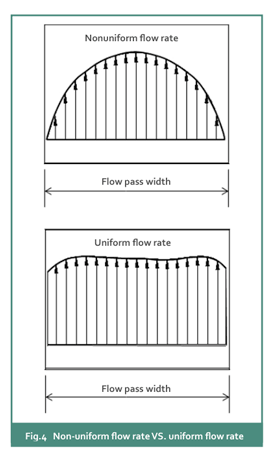
For a normal extruder, the difference of shearing force and that of flow rate are related to production capacity. The larger the actual capacity that is close to the rated value, the bigger the difference of shearing force and that of flow rate.
In view of above impacting factors, Muyang has developed the so called “turbulent flow extruding technology” to control pellet uniformity in aquafeed extrusion (See Fig.4). It is applied to well distribute the shearing force in the screw zone and to unify the flow rate in both the screw zone and to unify the non-screw zone (between end of screw and die plate) in an extruder chamber. The turbulent flow extruding technology can help extruder (especially the single-screw extruder) perform outstandingly in aquafeed production.
3. Application of Muyang innovations
By integrating the stabilized shearing technology and the reinforced conditioning technology as well as the turbulent flow extruding technology in one extruder, Muyang rolled out the MY120×2 I Twin-screw Extruder in Nov. 2009. With many sets’ reliably running in customers’ feed mills for more than one year, the MY120×2 I Twin-screw Extruder has been proven to perform well in energy efficiency improving and pellet uniformity control.




